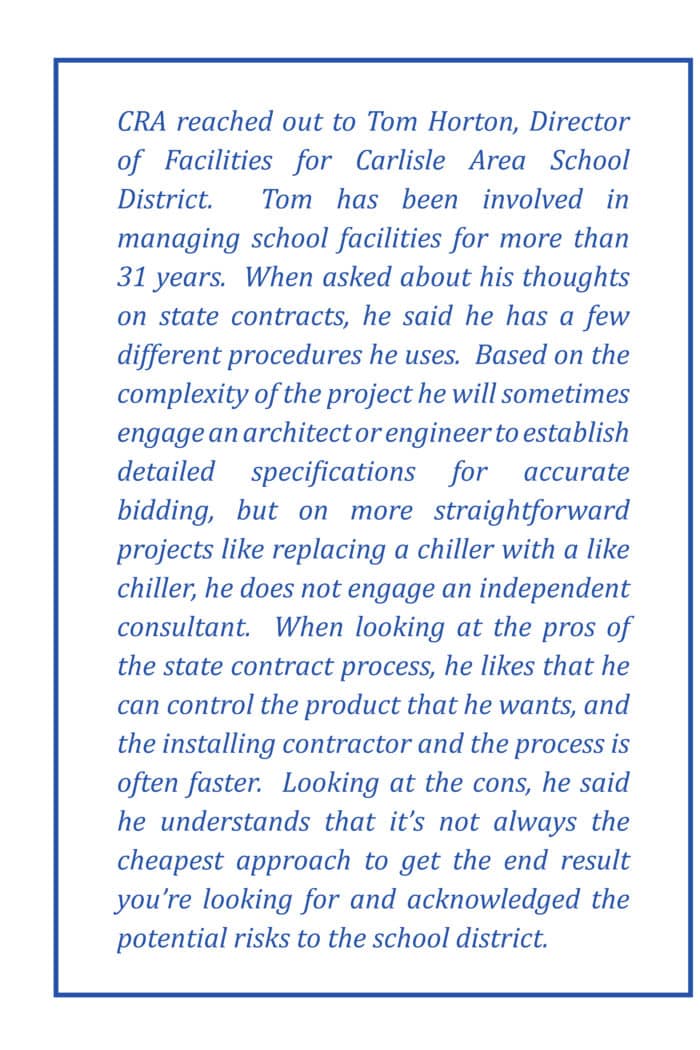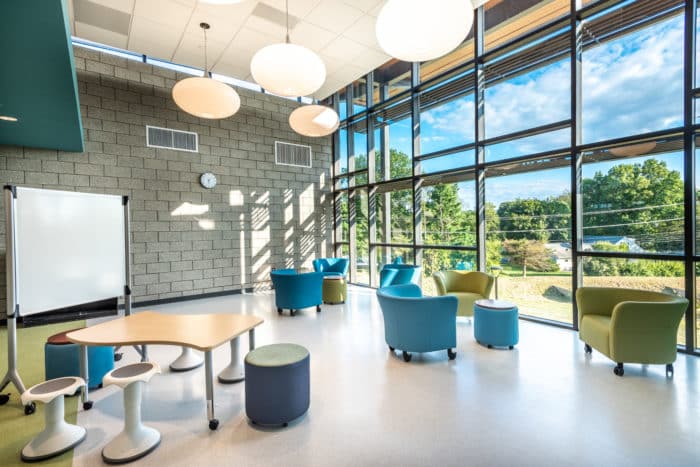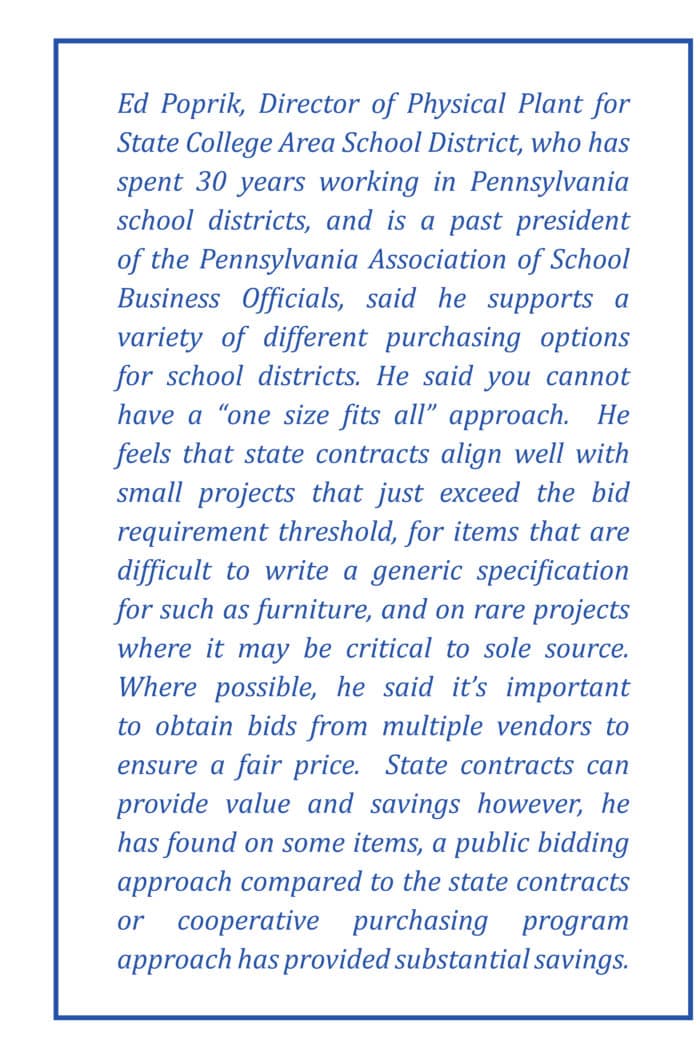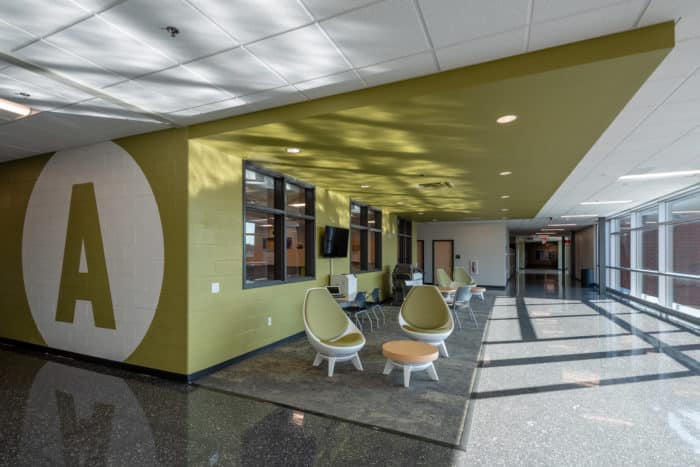Cooperative purchasing programs are used throughout the United States to allow school districts and other public entities to leverage their group buying power to save money and streamline the procurement process. The intent of this article is to review the pros and cons of using state contracts and cooperative programs as a delivery method for school district projects. We will discuss and compare the process of using a traditional design-bid-build approach vs. using non-competitive cooperative purchasing programs, and their impacts to cost and schedule.
Cooperative purchasing programs were created with the intent to save school districts and other public agencies time and money when procuring certain goods and services. These contracts preestablish pricing by soliciting bids from qualified vendors, leveraging the buying power of larger groups. Cooperative purchasing programs allow public entities to purchase directly without having to go through an independent bid process. Products and services can include among other things, building solutions, technology, general building supplies, furniture, energy, vehicles, custodial supplies, sports equipment, security, insurance, and music, etc. Our focus for this article will be on building solutions, furniture, safety and security products and services, all common needs for school districts. Objectively looking at facilities environments, there are some areas where cooperative purchasing programs have provided significant savings, but other scenarios where the cost savings have created potential liabilities and conflicts.

School districts sometimes use a cooperative purchasing approach for roof replacement projects, safety and security upgrades, synthetic turf installations and furniture or equipment, working in tandem with their design professional for facilities related projects. Crabtree, Rohrbaugh & Associates (CRA) has worked with many of its clients in a variety of different ways when they have considered using these types of procurement methods. As consultants, we’ve helped to guide school districts through this process, particularly when the products and services available supplement an active design project. It’s not uncommon to bid for these services both ways, 1) where a school district develops a set of bidding specifications to define the scope of work and 2) by direct purchasing through a cooperative purchasing program. This allows a district to compare the results and determine which approach best fits their needs.
Co-Ops and Building Improvements
In recent years, the use of cooperative purchasing programs has exploded as school districts seek both economies of scale and opportunities to reduce time spent on purchasing activities. The application of such purchasing strategies to construction services, while at times successful, has often proven to be problematic due to the complexity of a construction project. In many cases, a project may require independent professional oversight to ensure performance, a service not always provided by a cooperative purchasing program. In the Commonwealth of Pennsylvania, the lack of oversight for construction service projects has at times, resulted in a substantial waste of taxpayers’ dollars due to weaknesses in the model that largely circumvent state standards designed to ensure competitive bidding and avoid conflicts of interest.
When looking at facility improvement projects such as security entrances, roofing, etc., a school district typically engages an architect or engineer to develop the scope of work and prepare a set of bidding documents. The architect or engineer is responsible for understanding and applying all current building standards such as applicable building codes, safety standards and other requirements that will affect the design and overall scope of the project. CRA’s experience has shown that when the scope of work is not fully defined, or code upgrades are not comprehensively applied, the contractors have recommended improvements that do not meet current construction standards and could put the district at risk if they were to move forward with the improvements.
Cost is a key component of determining whether to move forward with a cooperative contract agreement. Often owners assume that since the products and services offered through these programs are bid competitively and ahead of time, they are automatically going to be low cost options. This has not always proven to be the case. Cooperative purchasing programs are competitively bid and have a predetermined value; however, they are not always the most cost-effective solution when moving forward with a project. Recent bid results have shown significant savings using the design-bid-build methodology when compared to a single source awarded cooperative purchasing agreement


Wallingford Strathmore School District engaged CRA for the design of security improvements at their high school. After defining the scope of work the district used the Keystone Purchasing Network (KPN), a local cooperative purchasing program, to develop a cost for their planned construction and improvements. The cost exceeded their budget and it was CRA’s recommendation to delay the project and to publicly bid it at a time where contractors would be looking for this type of work. This delay combined with the design-bid-build approach saved the District more than $300,000, an approximate 30% reduction in overall costs.
Chambersburg Area School District was looking to replace their emergency generator at their district administrative office and solicited proposals from two cooperative purchasing companies and both bids received were over their budget. They engaged CRA to publicly bid the project and the bids received were approximately $50,000 less than the previous bids and were under the district’s budget.
CRA is currently working with a local school district on renovations to their soccer and field hockey stadium. Most of the work is replacement of their turf field along with some other minor improvements. This project is an ideal candidate to be bid both by local contractors and through a cooperative purchasing program. CRA will evaluate the bid results and make a recommendation on which solution provides the best value for the school district. By engaging an architect and engineering team who is knowledgeable on all the current construction standards, and by bidding it both ways, we will ultimately be able to recommend the best value to the school district.
 State contracts and cooperative programs do allow an owner to streamline the process and not spend the time and money to develop a set of bidding documents. If the owner has a full knowledge of all requirements for their project, a state contract or a cooperative purchasing program approach can be a good delivery method. State contracts can be an appropriate and effective approach for purchasing furniture and equipment, but for building projects, it’s often better for an owner to engage an architect to develop a set of bidding documents to ensure the project truly meets their needs and all current construction standards.
State contracts and cooperative programs do allow an owner to streamline the process and not spend the time and money to develop a set of bidding documents. If the owner has a full knowledge of all requirements for their project, a state contract or a cooperative purchasing program approach can be a good delivery method. State contracts can be an appropriate and effective approach for purchasing furniture and equipment, but for building projects, it’s often better for an owner to engage an architect to develop a set of bidding documents to ensure the project truly meets their needs and all current construction standards.
The state contract and cooperative purchasing programs were developed to assist public entities with the purchase of common products, materials, and services to save them money and time. Crabtree, Rohrbaugh & Associates believes this process to have value, and supports its approach, but when applied to an appropriate project or need.
Understanding Cooperatives – They are not all the Same.
There is a common misunderstanding that all purchasing cooperatives are largely the same. This leads many public entities to overspend or to use cooperatives in a manner not entirely compliant with bidding laws.
In Pennsylvania there are several purchasing options available because the state allows public entities to use cooperatives for the purchase of certain goods and services. The Commonwealth of Pennsylvania has its own state contract cooperative called CoStars. This contract is run by the Department of Government Services (DGS) and allows all public entities to procure goods and services from a wide list of categories. This contract offers public entities a list of vendors that provide the state with competitive pricing that is negotiable throughout their purchasing process. CoStars awards its contracts to all “responsive and responsible bidders.” The PA DGS provides oversight of the CoStar’s program to ensure all vendors are responsible and responsive to public entity needs.
Another procurement avenue allowed in Pennsylvania is the cooperatives that are sometimes piggybacked from national purchasing programs. These contracts differ in single source awarded programs and multisource awards programs. The single source awarded programs are those that award to one vendor and have set pricing for public entities to use. Most often these programs are traced back to a private company that is for profit. Many of these programs will solicit a lead agency to disguise themselves as a not for profit publicly held company. Often this leads to public entities overpaying for their products and services as the contract is deployed through many channels adding fees and cost along the way.


There are other cooperative programs that offer public entities a more competitively priced procurement option but are less well known. These programs, such as TIPS-USA, are run by public entities and are truly non-profit. These programs award their contracts to multiple vendors creating a competitive price model that in turn offers favorable pricing back to public entities. They offer the same services and goods as any other cooperative but do not have a marketing machine backing them, so they are less well known. When compared to the larger contracts such as US Communities, Association of Educational Purchasing Agencies (AEPA), KPN and others, these programs can offer its members savings of 25% or significantly more. All of these programs offer free membership to public entities.
Understanding cooperatives is a complex and sometimes exhausting task. It is always best to do your homework and do what is best for your taxpayer base. Programs such as CoStars and TIPS-USA offer significant savings and many times pricing is at public bid levels. The ability of the public entity to secure competitive pricing and be able to get choices of respected qualified contractors serves a tremendous advantage over other purchasing contracts that serve only one purpose, adding profits to their bottom line.
Co-Ops & Roofing
Independent design professionals, most often registered architects or roof consultants, are experienced and trained in making material selections and weighing the pros and cons for the most suitable competitive alternatives without bias. By excluding them from the process, the cooperative purchasing approach may open school districts up to higher costs and increased liability should problems be discovered in the future. In one recent example, a school district was provided with a proposal for roofing replacement, which upon detailed review, CRA discovered the proposal did not comply with the recent State energy code.

When roofing projects are purchased through a single-source cooperative purchasing agreement the roofing manufacturer is often acting as the project designer, the general contractor, and the installer. Third party design professionals are often not consulted, which in many states can violate their procurement laws and not comply with all construction codes.
A study conducted in Pennsylvania by Ducker Worldwide examined the costs per square foot for the most common roofing systems used – EPDM rubber roofs, TPO thermoplastic roofs and asphaltic built up roofs. They found that prices ranged from $8 to $11 per square foot on the private and public markets. However, when they analyzed over 70 contracts made by school districts using single-sourced purchasing cooperatives, the prices averaged more than $21.
It’s important that school districts understand these cost impacts and the potential liability of these types of arrangements prior to entering into direct agreements as compared to procurement through public, competitive bidding.
Conclusion
It is important that school districts and other public entities have multiple procurement options available to them to fit their varying needs on a project-by-project basis. State cooperative purchasing agreements provide a procurement method that allows for multiple districts to leverage their buying power to provide cost savings. Based on the type of product or service needed, specifically construction related services, it’s important that the district understands the overall impact of the purchase to their budget and schedule. By understanding this, school districts will be able to make the best-informed decision about these types of purchases.




